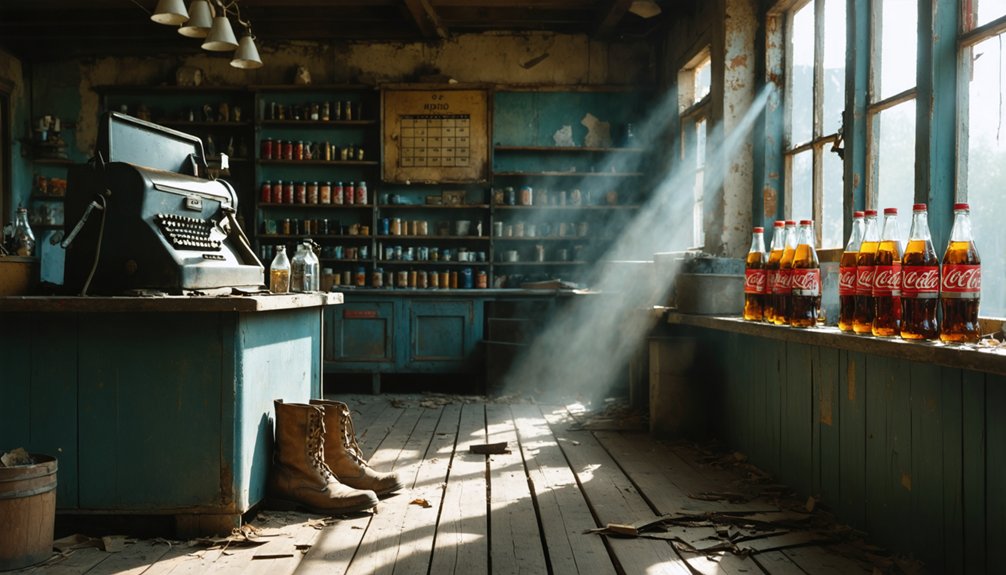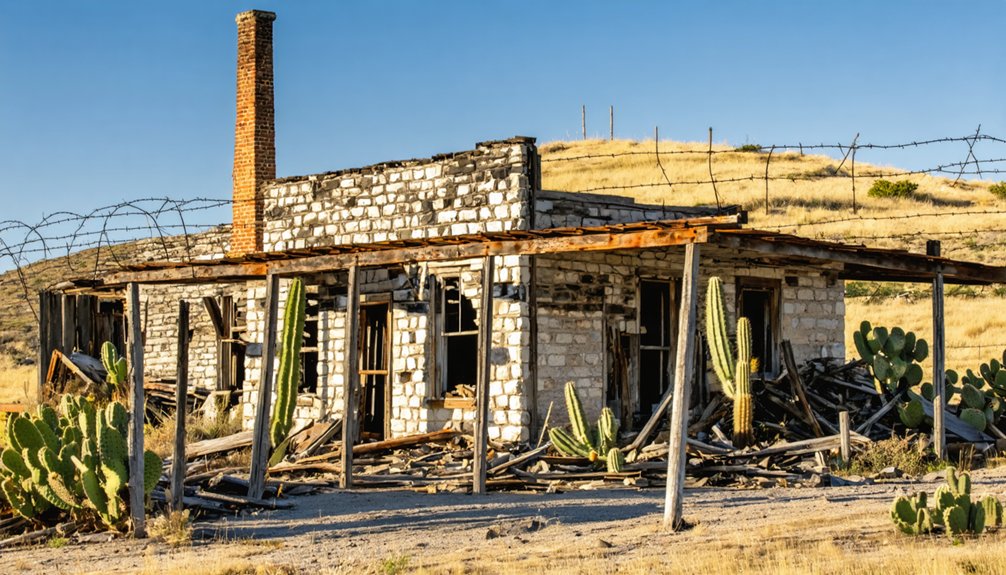You’ll find Cain City tucked away in Texas Hill Country, a ghost town born from railroad dreams in 1913. Named after Charlie Cain, this once-bustling hub boasted a train depot, hotel, lumberyard, and general stores, serving as an essential shipping point between Fredericksburg and Johnson City. Though it peaked at 75 residents in 1925, the town’s decline followed the railway’s closure in the 1940s. Today, its 920-foot tunnel and scattered ruins whisper stories of Texas’ railroad era.
Key Takeaways
- Cain City, Texas was a railroad town established in 1913 that grew rapidly but became abandoned by the mid-1940s.
- The town reached its peak population of 75 residents in 1925 before declining due to economic challenges.
- Major facilities included a train depot, hotel, lumberyard, school, bank, post office, and multiple general stores.
- The town’s fate was sealed when the Fredericksburg and Northern Railway ceased operations between 1942 and 1944.
- Today, remnants include a 920-foot railroad tunnel preserved at Old Tunnel State Park and scattered railway infrastructure.
The Birth of a Railroad Dream (1913-1915)
Two pivotal events in 1913 set the stage for Cain City’s brief but notable existence. First, the San Antonio, Fredericksburg and Northern Railway received its charter on January 3, with prominent directors like James M. Dobie leading the charge to connect Fredericksburg with the broader Texas rail network.
Second, banker J.C. Stinson strategically purchased 324 acres in Gillespie County, where surveyor A.J. Green would lay out the future townsite. The town was named after Charlie Cain, who had established himself in the Texas business world. Today, railroad enthusiasts can learn more about Texas railway history at 11731 Wetmore Road in San Antonio.
The railway construction proved ambitious, featuring a 920-foot tunnel that cost $134,000. You’ll find it interesting that despite the early optimism, financial challenges quickly emerged.
A Town’s Swift Rise to Regional Prominence
Thanks to Charles Matthew Cain‘s substantial fundraising efforts, Cain City rapidly transformed from empty ranchland into a bustling railroad hub in 1913.
You’d have witnessed the swift construction of essential facilities – a train depot, hotel, lumberyard, school, bank, post office, and general stores – all within the first year of development.
The town’s population dynamics reflected classic boomtown patterns, reaching about 75 residents by 1925.
As the Fredericksburg and Northern Railway established operations, economic opportunities flourished. You could’ve found multiple general stores, a produce warehouse, and a modern water system supporting both commerce and daily life.
The newly platted 324-acre townsite, surveyed by A.J. Green, connected to Luckenbach via rural roads, making Cain City a crucial shipping and transit hub for Gillespie County and nearby Fredericksburg.
The short line railroad ceased all operations in October 1944, marking the beginning of the end for the once-promising town.
The town’s prosperity was short-lived as economic challenges and the eventual closure of railway operations in the 1940s led to its decline.
Life in Early Cain City: Commerce and Community

Life in early Cain City revolved around a diverse mix of commercial establishments and community spaces that served both locals and travelers passing through.
You’d find Tom Schmidt’s Farmers’ Produce Company warehouse handling agricultural supply needs, while Alfred Jung’s lumberyard supported local construction. The town’s infrastructure included modern amenities like telephone service and a post office run by Hugo Pahl. Like neighboring Luckenbach, the community benefited from German immigrant settlers who brought their entrepreneurial spirit.
Two general stores kept residents stocked with daily necessities, and Gus Bausch’s cotton gin supported local farmers. Following the regional trend, the gin processed crops from local farms that produced over 15,000 bushels of corn annually.
Community events centered around the schoolhouse, where Katie Striegler taught, and the Mountain Home Hotel welcomed visitors.
For entertainment, you could join your neighbors at dance halls operated by Edgar Tatsch and Theodore Keller, which kept the social spirit alive even as the town faced economic challenges.
The Final Whistle: Decline and Abandonment
While Cain City’s early years showed promise with its bustling railway stop and growing businesses, the town’s decline began creeping in during the early 1920s.
Once a symbol of frontier potential, Cain City witnessed its own gradual unraveling as the 1920s dawned on its bustling streets.
You’ll find that economic factors played a devastating role, as commerce dwindled and the population peaked at just 75 residents in 1925.
The railway significance can’t be overstated – when the Fredericksburg and Northern Railway ceased operations between 1942 and 1944, it spelled doom for the remaining townspeople.
Without this crucial transportation lifeline, businesses shuttered and residents relocated. By the mid-1940s, you’d have found nothing but abandoned buildings.
Today, there’s barely a trace of the once-hopeful settlement – no standing structures remain, and the land’s privately owned. Cain City joins 511 ghost towns scattered across Texas, each telling its own story of rise and fall.
All that’s left are historical records and photographs documenting Cain City’s brief existence.
What Remains: Traces of Texas Railroad History
Despite the passage of time, significant physical remnants of Cain City’s railroad era persist today, offering tangible connections to Texas’s transportation history.
You’ll find the most impressive railroad remnant in the 920-foot tunnel that once carried trains through the hills but now houses millions of Mexican free-tailed bats. The old Fredericksburg depot still stands, though it’s tucked behind modern development, and you can spot rusty spikes and earthworks that occasionally surface during farming. Each night during peak season, visitors can witness these bats consume over 25 tons of insects.
As you explore this ghost town, you’ll notice unnatural embankments that trace the former rail line’s path through the landscape. The railroad’s legacy lives on at Old Tunnel State Park, where 16 acres of protected land preserve both historical infrastructure and essential wildlife habitat. Following its unsustainable financial losses, the railroad was sold for $77,000 to a Chicago company in 1942.
Frequently Asked Questions
Were There Any Notable Crimes or Lawlessness During Cain City’s Existence?
Truth is stranger than fiction, but you won’t find any documented crime incidents or law enforcement problems here. Historical records don’t show any notable lawlessness during the town’s short-lived existence.
What Happened to the Families Who Lived in Cain City?
You’ll find these families gradually moved away due to economic decline, starting in 1922. They scattered to nearby towns like Fredericksburg, larger cities, or other places offering better job prospects and stability.
Did Native Americans Have Any Significant Interaction With Cain City?
Like ships passing in time’s ocean, you won’t find direct cultural exchanges between Native Americans and Cain City – it was established in 1913, long after tribes had already been displaced from Gillespie County.
Was Cain City Affected by the 1918 Spanish Flu Pandemic?
You won’t find direct records of Spanish Flu cases in Cain City, but given the pandemic’s widespread health impact throughout Texas in 1918, it’s highly likely the town experienced illness and deaths.
Did Any Famous People Ever Visit or Pass Through Cain City?
Like a quiet dance hall on a Tuesday night, you won’t find any A-list historical visitors here. While local businessmen kept things moving, there’s no record of famous folks passing through.
References
- https://texashillcountry.com/ghost-towns-explore-quarantine-ends-part/
- https://kids.kiddle.co/Cain_City
- https://www.wikiwand.com/en/map/Cain_City
- https://www.ghosttowns.com/states/tx/caincity.html
- https://texashillcountry.com/hill-country-ghost-town-road-trip/2/
- https://discovertexasoutdoors.com/places/cain-city/
- https://en.wikipedia.org/wiki/List_of_ghost_towns_in_Texas
- https://www.tshaonline.org/handbook/entries/cain-city-tx
- https://www.texasescapes.com/MichaelBarr/Cain-City.htm
- https://en.wikipedia.org/wiki/Cain_City



